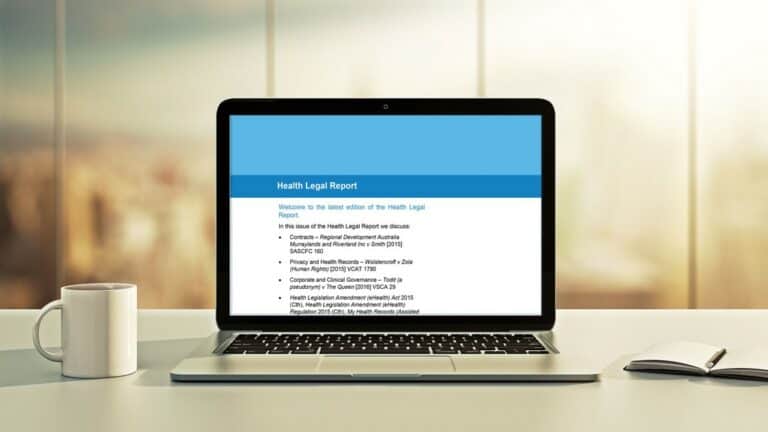Austen v Tran [2022] ACTSC 114
Introduction
In this case, Sandra Austen (the plaintiff), claimed medical negligence against Dr Tuan Quoc Tran (the defendant). The defendant attended to the plaintiff for two consultations.
On 19 September 2017, the defendant diagnosed the plaintiff with terminal non-Hodgkin’s lymphoma. The plaintiff alleged that the defendant failed to take steps to diagnose her condition earlier and that an early diagnosis would have improved her prognosis and life expectancy. On the balance of probabilities, the Court held that the defendant had not breached his duty of care and the defendant did not cause the plaintiff to have non-Hodgkin’s lymphoma.
Facts
The first consultation with the defendant
On 17 October 2016, the plaintiff had an appointment with the defendant at the Wattle Street Medical Practice (Practice). The plaintiff last visited the Practice on 5 January 2012 about her mental health. The plaintiff had long-term mental health issues and was on a disability pension. The first consultation on 17 October 2016 lasted no more than 15 minutes, with the defendant examining the plaintiff and taking clinical notes regarding the pain in her leg, noting the severity of the pain as being 8/10. However, there were some discrepancies between the defendant’s clinical notes and the plaintiff’s evidence, with the plaintiff alleging that she reported the pain in her left leg as opposed to her right. The defendant ordered blood tests as part of a differential diagnosis that he thought might be due to iron deficiency. The defendant was also prescribed Anaprox as an anti-inflammatory and a pain reliever to treat her moderate pain.
Consultation with Dr Jazwari
On 19 June 2017, the plaintiff visited the Practice and saw Dr Jazwari. The plaintiff reported left foot/leg pain in the previous three nights. Dr Jazwari referred her for a CT of the lumbar spine on 21 June 2017, and the plaintiff underwent blood tests, with the blood tests showing elevated levels of Alkaline Phosphoshatase and CRP. The plaintiff scheduled a care plan modification with Dr Jazwari.
The second consultation with the defendant
On 15 July 2017, the plaintiff went for a second consultation with the defendant, complaining of acute and severe pain in her lower back and left leg. The defendant diagnosed the plaintiff with arthritis and prescribed Anaprox. The defendant also referred her for x-rays and an ultrasound on her left hip and left knee. The x-rays and ultrasound were not carried out until 8 and 9 August 2017. After the test, it was recommended in the radiology report to evaluate the sacroiliac joints for possible abnormalities and, if not, to consider CT and MRI of the lumbosacral spine. Despite the recommendation, the defendant did not follow up or refer the plaintiff for further x‑rays.
The diagnosis and treatment
In early September 2017, the plaintiff was referred for an MRI of the lumbar spine, which identified “bony lesions – metastasis multiple”. Subsequently, the plaintiff underwent a CT scan for a whole-body bone scan, and biopsies were performed. As a result, the plaintiff was diagnosed with non-Hodgkin’s lymphoma, which was terminal.
The plaintiff commenced chemotherapy and was declared to be in remission from May 2018 for 15 months.
Issues
The issues for determination were:
- In relation to either the first consultation or the second consultation, whether the defendant breached the duty of care owed to the plaintiff; and
- If there was a breach, whether the defendant’s breach caused the injuries and disabilities to the plaintiff.
Decision
It is generally accepted that a doctor owes a duty of care and to exercise reasonable care and skill to examine, diagnose and treat their patient. Section 42 of the Civil Law (Wrongs) Act 2002 (ACT) (the CLW Act) provides:
For deciding whether a person (the defendant) was negligent, the standard of care required of the defendant is that of a reasonable person in the defendant’s position who was in possession of all the information that the defendant either had, or ought reasonably to have had, at the time of the incident out of which the harm arose.…
The Court noted that a cautious approach had been taken in avoiding giving the clinical notes higher weight than other evidence presented in the proceedings. The Court reasoned that clinical notes are usually taken primarily as a summary of the consultation and do not include the questions asked by the health professional to clarify the patient’s response during the consultation.
Duty of care
Section 43 of the CLW Act provides that a person is not negligent in failing to take precautions against a risk of harm unless the risk is foreseeable, not insignificant and that a reasonable person would have taken the precautions in the circumstances. Accordingly, the Court must consider the probability of harm if precautions were not taken, the seriousness of the harm, the burden of taking precautions to avoid the risk of harm and the social utility creating the risk of harm.
The plaintiff contended that the defendant fell short in his duty of care as the defendant did not properly investigate, make a proper diagnosis nor properly treat the plaintiff. In addition, the plaintiff contended that the defendant failed to refer the plaintiff for further investigation in relation to the second consultation. Thus, based on the plaintiff’s argument, it was a combination of several acts and omissions by the defendant that resulted in a breach of duty.
The Court accepted that the defendant failed to conduct a thorough investigation of the plaintiff’s symptoms and complaints. However, to determine whether there was a breach of duty of care, the consultation as a whole and the circumstances at the time of the consultation must be considered. It was accepted by expert evidence that the defendant’s notes in the first consultation were substandard. Despite this, the defendant’s overall actions would be widely accepted as competent professional practice in Australia.
Importantly, the Court was critical of the plaintiff’s submissions regarding the lack of investigations or referrals at the second consultation. Although a more thorough investigation could have been conducted, it does not mean that the defendant’s actions fell short of the required standard. The defendant conducted a basic examination and this was taken to form part of the precautionary measures to guard against the risk of harm. The basic examination conducted by the defendant was not so poor as to breach the duty of care owed by a reasonable general practitioner.
Additionally, based on the number of other steps the defendant took after the examination, the defendant did not violate the standard of care expected of a reasonable general practitioner. There was no suggestion that a reasonably skilled medical practitioner would have taken a different approach. Observing whether the plaintiff’s pain dissipated with time after taking pain relief was reasonable. Therefore, it was reasonable to conduct x-rays and ultrasound after the plaintiff reported further pain during the second consultation.
Causation
Section 45 of the CLW Act provides that to prove causation, the harm must have happened because of the defendant’s negligence (factual causation) and that the scope of the negligence must extend to the harm caused (the scope of liability). In deciding the scope of liability, the Court must consider (among other relevant things) whether or not, and why, responsibility for the harm should be imposed on the negligent party.
Did the breach arise out of the first consultation?
For causation to be made out, firstly, the plaintiff must show that a reasonably competent general practitioner would have been able to detect the existence of non-Hodgkin’s lymphoma at the time of the first or second consultation. Secondly, the plaintiff must prove that if the defendant had not taken those precautions, the condition would likely have been diagnosed sooner, and it would be more probable than not that the plaintiff would have avoided the harm, or that the extent of the plaintiff’s injuries would have been reduced.
Based on expert evidence, the plaintiff had low grade lymphoma from at least October 2016 and progressed to high-grade lymphoma shortly before 2017. However, the lymphoma could only be detected by a PET scan at the early stage. The plaintiff’s low-grade lymphoma would not have been detected even if the x-rays and CT scan were carried out in October 2016 after the first consultation.
Given the circumstances at that time, it would not have been reasonable to carry out a PET scan after the first consultation. The initial presentation of leg pain, weakness and other symptoms were rare in non-Hodgkin’s lymphoma. Moreover, a medical practitioner would not have been able to order a PET scan as a referral to a specialist must first be sought. It is unlikely that the plaintiff would have been referred to a specialist and undergone a PET scan earlier than June/July 2017.
Accordingly, it cannot be said that the defendant’s actions resulted in a delay in diagnosis arising out of the first consultation.
Did the breach arise out of the second consultation?
For the plaintiff to establish a breach arising from the second consultation, the plaintiff must show that a diagnosis by the defendant, months earlier in 2016, would have resulted in the plaintiff being free of non-Hodgkin’s lymphoma. However, it was accepted as evidence that if the plaintiff had commenced chemotherapy in early August 2017, the plaintiff would only have had a longer remission period for a further 12 months.
The Court further noted that an improved remission period was a mere possibility, not a probability. In other words, even if the plaintiff had been diagnosed and treated a few weeks earlier, the plaintiff would have had a slightly better chance of having a more extended period of remission, not completely avoiding the disease.
Compliance Impact
In cases involving delayed cancer diagnosis, plaintiffs face certain evidential challenges, particularly proving on the balance of probabilities that the medical practitioner’s breach caused the plaintiff’s injury. It may be challenging to demonstrate that the injury and its consequences could have been avoided had the delay in diagnosis not occurred.
To establish a breach of duty, the plaintiff must show that, but for the defendant’s breach, the plaintiff would not have suffered the disease. Notably, it is insufficient to prove causation if the plaintiff had lost a chance of a better outcome. The plaintiff must show that the plaintiff would have had a better outcome but for the defendant’s negligent conduct.




